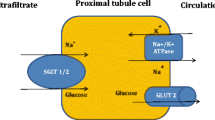Abstract
Ranolazine is an anti-anginal medication that reduces the sodium-dependent calcium overload via the inhibition of the late sodium current. After its approval for the treatment of chronic angina in 2006 in the USA, ranolazine has been reported to have several pleiotropic effects on various cardiac conditions, such as atrial fibrillation, ventricular arrhythmias, diastolic and microvascular dysfunction, and pulmonary arterial hypertension. Recently, several studies reported some promising results on the potential benefits of ranolazine on glycemic control. Though the mechanism of the antihyperglycemic effect is still unknown, ranolazine may exert the effect through β cell preservation, inhibition of glucose secretion, and enhancement of insulin secretion in a glucose-dependent manner. Given the increased risk of cardiovascular disease in patients with diabetes, it will be useful if one medication can simultaneously improve chronic angina and diabetes. Therefore, ranolazine could be a favored choice among other anti-anginal agents for patients with comorbidity of chronic angina and diabetes mellitus. In this review, we summarize the available data from clinical studies and provide valuable insight into defining the target population for the antihyperglycemic effect of ranolazine.
Similar content being viewed by others
References
Nash DT, Nash SD. Ranolazine for chronic stable angina. Lancet. 2008;372(9646):1335–41.
Banerjee K, et al. Role of ranolazine in cardiovascular disease and diabetes: exploring beyond angina. Int J Cardiol. 2017;227:556–64.
Gilbert BW, et al. Antihyperglycemic and metabolic effects of ranolazine in patients with diabetes mellitus. Am J Cardiol. 2018;121(4):509–12.
Greiner L, Hurren K, Brenner M. Ranolazine and its effects on hemoglobin A1C. Ann Pharmacother. 2016;50(5):410–5.
Zeng X, et al. Efficacy and safety of ranolazine in diabetic patients: a systematic review and meta-analysis. Ann Pharmacother. 2017:1060028017747901.
Chaitman BR. Ranolazine for the treatment of chronic angina and potential use in other cardiovascular conditions. Circulation. 2006;113(20):2462–72.
Dhalla AK, et al. Ranolazine, an antianginal agent, markedly reduces ventricular arrhythmias induced by ischemia and ischemia-reperfusion. Am J Physiol Heart Circ Physiol. 2009;297(5):H1923–9.
Dhalla AK, et al. Blockade of Na+ channels in pancreatic alpha-cells has antidiabetic effects. Diabetes. 2014;63(10):3545–56.
Ning Y, et al. Ranolazine increases beta-cell survival and improves glucose homeostasis in low-dose streptozotocin-induced diabetes in mice. J Pharmacol Exp Ther. 2011;337(1):50–8.
Fu Z, et al. Ranolazine recruits muscle microvasculature and enhances insulin action in rats. J Physiol. 2013;591(20):5235–49.
Timmis AD, Chaitman BR, Crager M. Effects of ranolazine on exercise tolerance and HbA1c in patients with chronic angina and diabetes. Eur Heart J. 2006;27(1):42–8.
Morrow DA, et al. Evaluation of the glycometabolic effects of ranolazine in patients with and without diabetes mellitus in the MERLIN-TIMI 36 randomized controlled trial. Circulation. 2009;119(15):2032–9.
Pettus J, et al. Effect of ranolazine on glycaemic control in patients with type 2 diabetes treated with either glimepiride or metformin. Diabetes Obes Metab. 2016;18(5):463–74.
Fanaroff AC, et al. Ranolazine after incomplete percutaneous coronary revascularization in patients with versus without diabetes mellitus: RIVER-PCI Trial. J Am Coll Cardiol. 2017;69(18):2304–13.
Zack J, et al. Pharmacokinetic drug-drug interaction study of ranolazine and metformin in subjects with type 2 diabetes mellitus. Clin Pharmacol Drug Dev. 2015;4(2):121–9.
Eckel RH, et al. Effect of ranolazine monotherapy on glycemic control in subjects with type 2 diabetes. Diabetes Care. 2015;38(7):1189–96.
Chisholm JW, et al. Effect of ranolazine on A1C and glucose levels in hyperglycemic patients with non-ST elevation acute coronary syndrome. Diabetes Care. 2010;33(6):1163–8.
Kipnes M, et al. A study to assess the metabolic effects of ranolazine when added to ongoing non-insulin medical therapy in subjects with type 2 diabetes mellitus (T2DM). Diabetes. 2011;60:A316.
Sandhiya S, et al. Comparison of ranolazine and trimetazidine on glycemic status in diabetic patients with coronary artery disease—a randomized controlled trial. J Clin Diagn Res. 2015;9(1):OC01–5.
Lopaschuk GD, et al. Beneficial effects of trimetazidine in ex vivo working ischemic hearts are due to a stimulation of glucose oxidation secondary to inhibition of long-chain 3-ketoacyl coenzyme a thiolase. Circ Res. 2003;93(3):e33–7.
Greiner L, Hurren K, Brenner M. The effects of ranolazine on hemoglobin A1c in a veteran population. Fed Pract. 2018;35(5):44–8.
RANEXA® (ranolazine) extended-release tablets [package insert]. Foster City: Gilead Sciences, Inc; 2016.
Author information
Authors and Affiliations
Corresponding author
Additional information
Publisher’s Note
Springer Nature remains neutral with regard to jurisdictional claims in published maps and institutional affiliations.
Rights and permissions
About this article
Cite this article
Lisi, D., Andrews, E., Parry, C. et al. The Effect of Ranolazine on Glycemic Control: a Narrative Review to Define the Target Population. Cardiovasc Drugs Ther 33, 755–761 (2019). https://doi.org/10.1007/s10557-019-06917-6
Published:
Issue Date:
DOI: https://doi.org/10.1007/s10557-019-06917-6




